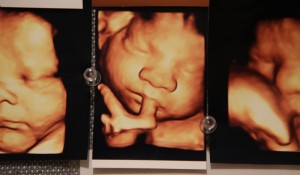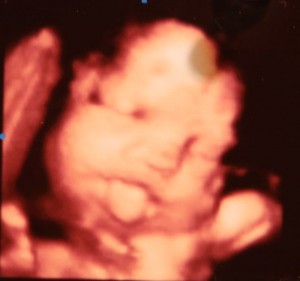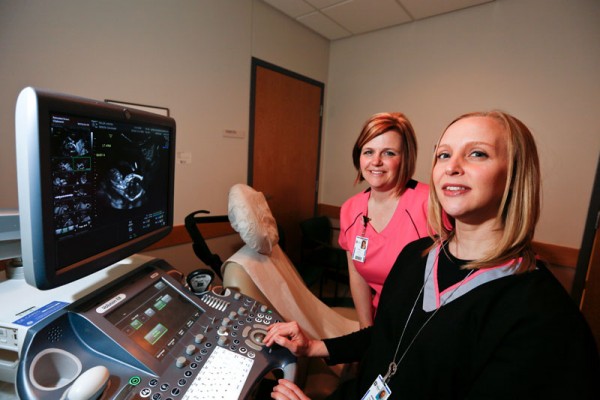
From peace signs and waves to martial arts kicks, prenatal ultrasound techs Shelly Kemppel (on left) and Jen Burnett have seen it all.
One of the latest trending videos features an ultrasound of a 14-week-old fetus clapping while her parents sing the popular nursery rhyme, “If you’re happy and you know it, clap your hands.”
This video generated all sorts of online discussions about whether this was indeed possible. Can the fetus react to sounds, music and the like? Or was it a reflex like the hiccups? What exactly does go on in there?
To answer these questions, I asked 3 registered ultrasound technologists in Akron Children’s maternal fetal medicine center to respond to the top prenatal ultrasound antics.
Clapping hands
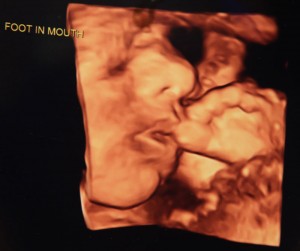 While none of the ultrasound techs recall seeing a 14-week fetus clapping, they did say that deliberate clapping at 14 weeks to a toddler’s favorite song may be a stretch. A baby’s senses, including hearing, don’t start to develop until 19 weeks.
While none of the ultrasound techs recall seeing a 14-week fetus clapping, they did say that deliberate clapping at 14 weeks to a toddler’s favorite song may be a stretch. A baby’s senses, including hearing, don’t start to develop until 19 weeks.
So, what is happening in the womb during that first and second trimester?
“At 8 weeks they start wiggling, and at 12 to 13 weeks they start to open their hands,” said ultrasound tech Wendy Barberic.
She added that by 20 weeks she sees all kinds of hand movements including what appears to be baby waves and thumb-sucking.
Ultrasound tech Jennifer Burnett describes first trimester wiggles as “uncontrolled body movements.”
“When expectant moms see these movements, they are so surprised because they can’t feel fluttering yet,” Burnett said.
That changes as they get farther along in their pregnancy.
“At 20 weeks you see much more controlled movements,” Burnett said. “They are rolling, sucking their thumb, and their hands are constantly in their faces, especially when we are trying to analyze facial anatomy.”
Those who study fetal development agree. According to researcher Niamh Nolan, of Imperial College in London, fetal movements begin at 7 weeks gestation with twitches, stretches and whole body movements.
At 14 to 15 weeks, the developing baby can move arms and legs extensively, and around 18 weeks, much more flexing occurs.
Thumbs up and peace sign
All the techs have observed a fetus giving a “thumbs-up” and what appears to be a peace sign gesture at 20 weeks. Although they feel this is a random event, parents react positively to it.
“I think parents want it to be so personal,” said ultrasound tech Shelly Kemppel, who often types, ‘hi mom,’ or ‘peace’ on their personal picture. “It simply adds to their joy.”
Italian researcher Umberto Castiello showed that within only a few hours after birth babies imitate gestures of people around them.
But, can they imitate in the womb? Probably not says Kemppel, but it’s a great tension cutter.
And all the techs agree these types of sightings make their job fun.
Raspberries and other facial expressions
Barberic, Burnett and Kemppel have seen facial expressions as early as 14 weeks.
“I’ve seen every kind of expression, from smiling and laughing to mad, crying looking,” Burnett said.
They’ve also all seen the tongue-out, raspberry-like facial expression.
Dr. Nadja Reissland, a researcher and psychologist who specializes in fetal development at Durham University, found that younger fetuses make spontaneous expressions while older ones hold those expressions. She suggests these expressions are not a sign of emotion but a form of practice as the fetus prepares to enter the social world.
Dancing baby
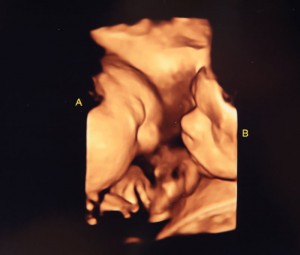 You can find many ultrasound videos of babies dancing in utero.
You can find many ultrasound videos of babies dancing in utero.
Barberic reports she’s seen kicks that look like dancing, especially with twins.
“I’ve seen legs moving, kicking and head flung back,” she said.
Researchers support these observations, reporting that at 21 weeks there is full kicking – somewhat like martial arts.
An Irish study revealed that babies move in reaction to sound as early as 16 weeks. This was earlier than previous estimates and before completion of the ear development, suggesting there is more to hearing than the ear alone.
Kemppel confirms this observation.
“When we need to have them roll over to get a certain part of baby’s anatomy, we buzz them (using a device that sounds like a doorbell) and they move like crazy,” Kemppel said.
So when you see those amazing ultrasounds trending on YouTube, it’s important to view them with intelligent skepticism. But as a veteran ultrasound tech puts it, “They’re all amazing!”








